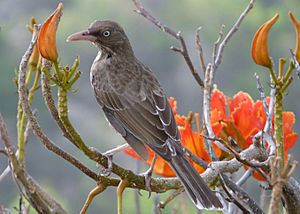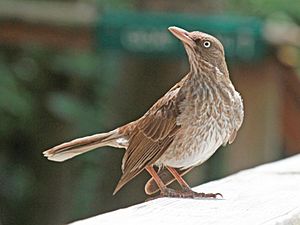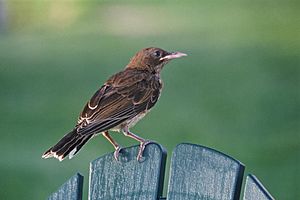Pearly-eyed thrasher facts for kids
Quick facts for kids Pearly-eyed thrasher |
|
|---|---|
 |
|
| On Guana Island, British Virgin Islands | |
| Conservation status | |
| Scientific classification | |
| Genus: |
Margarops
|
| Species: |
fuscatus
|
| Subspecies | |
|
M. f. fuscatus (Vieillot, 1808) |
|
The pearly-eyed thrasher (Margarops fuscatus) is a type of bird. It belongs to the thrasher family, called Mimidae. You can find this bird on many Caribbean islands. These islands stretch from the Bahamas in the north to the Grenadines in the south. There is also a group living on Bonaire.
This bird is known for being aggressive. It eats many different things, making it an omnivore. Its main food is large insects. But it also enjoys fruits and berries. Sometimes, it will even eat lizards, frogs, small crabs, or other birds' eggs and baby birds.
Pearly-eyed thrashers grow to be about 28 to 30 cm (11 to 11.8 inches) long. They build their nests inside holes, or cavities. Because of this, they sometimes compete for nesting spots with the Puerto Rican amazon. This parrot is in danger of disappearing. Pearly-eyed thrashers might even break the eggs of these parrots.
What it Looks Like
The pearly-eyed thrasher is the biggest bird in the Mimidae family. This family includes thrashers, mockingbirds, and tremblers.
Where it Lives
The pearly-eyed thrasher lives in the Bahamas, Puerto Rico, and the Virgin Islands. It also lives in the Turks and Caicos islands and the Dominican Republic. You can find it on many of the Lesser Antilles islands and Bonaire.
This bird likes to live in bushes and trees. It prefers mountain forests and coffee farms.
In Puerto Rico, it lives on the main island and Mona island. In the Bahamas, it nests on islands like San Salvador and Long Island. It also spends winters on islands like Eleuthra.
In the Lesser Antilles, it nests on islands such as Barbuda, Antigua, Guadeloupe, and St. Lucia. It used to live on Grenada but is now thought to be gone from there.
A group of these birds, called bonairensis, used to live near Venezuela. They were last seen in 1908 and are now believed to be extinct there.
Life and Habits
The pearly-eyed thrasher is an aggressive bird. It eats many different things. Its main food is large insects. But it also eats fruits and berries. Sometimes, it will eat lizards, frogs, small crabs, or other birds' eggs and baby birds.
This bird builds its nests in holes. In Puerto Rico, it sometimes competes for nesting spots with the critically endangered Puerto Rican Amazon. They might even destroy the eggs of these parrots.
Images for kids
See also
 In Spanish: Cuitlacoche chucho para niños
In Spanish: Cuitlacoche chucho para niños





